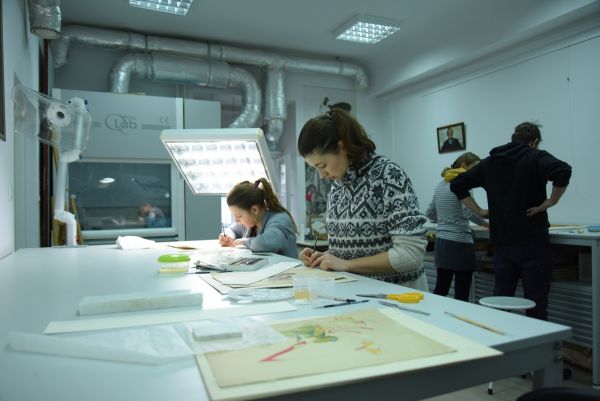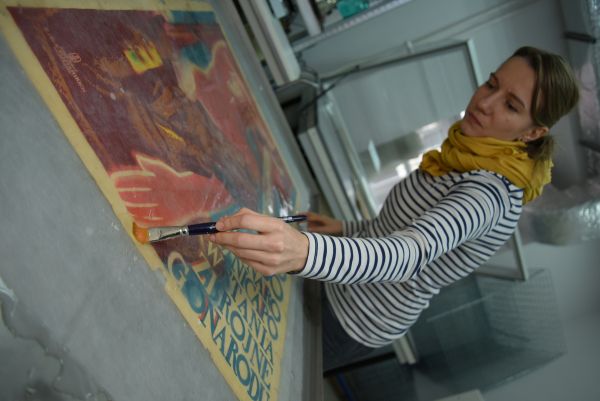The main impulse of the dynamic development of restoration in Poland stemmed from damages done to Polish heritage during the WWII. The Krakow’s Faculty of Conservation and Restoration of Works of Art had been one of the co-authors of shaping the particular study programme in Poland, that joins art with science. It has become a part of what is widely recognized as the Polish school of restoration.
The basis of teaching at the Faculty is direct contact of a student with a piece of artwork, a lot of practical work, which fosters „masters and pupil” type of relationship. Faculty organizes various workshops and exhibitions. For instance, there are regular exhibitions of students’ works: paintings executed during open-air workshops, copies and restored paintings.



































Departments
Department of Conservation and Restoration of Mural Paintings
The curriculum is based on the direct contact of a student with a historic artefact structure and recognize its artistic and historic values. Preparing students to work as a team, which is a characteristic for most of the wall paintings’ conservation and documentation projects, is one of the basic objectives of the present teaching model. There are only few members of the staff, but all are very much involved in teaching. This makes it possible to organize field work; otherwise restoring original artefacts and experiencing collective work would not be possible.
Department of Conservation and Restoration of Easel Paintings
There are three specialists' studios (Paintings on Canvas, Panel Paintings and Paintings on Paper) where students can gather experience in various issues of painting restoration.An important issue of the curriculum has been developing student’s abilities in investigating the structure a piece of artwork along with its technology and technique, recognition and eventual removal of secondary additions, and defining causes and types of deterioration. There are exercises in facing and treating structural problems of wooden and canvas supports.
Department of Conservation and Restoration of Sculpture
The objective of the Department is to educate students in the restoration of sculpture raising their sensitivity to form, texture and coloring of the restored material. Exercises are carried out on historic sculptures with varied technological structures and they are based on individual work with the entire scope of restoration procedures, including researching, investigating an artefact’s history and documenting the whole process, thus students have to cope both with theoretic and practical issues.
Department of Technology and Techniques of Works of Art
Students get accustomed with various techniques applied in wall paintings based on mineral media, but lime technique, fresco secco, stereochromy, mosaic and sgrafitto are discussed in detail. Students acquire knowledge on various technical issues, easel paintings structure, they study and exercise tempera technique based on the examples of icons and Małopolska panel paintings as well as on oil and oil-resin paintings dated to 16th and 18th century from museum collections. They also exercise gilding techniques and gain knowledge about basic materials used in sculpture, their properties and limitations of usage. During exercises students make copies of artwork and compositions keeping with historic styles and employing historic technology and techniques.
Department of General Art Studies
The main objective of education in painting is mastering artistic skills of future conservators. Exercises encompass three main topics i.e.: human body, still life and landscape. Starting with classical studies on still life students develop abilities in creating both realistic and abstract (unsubstantial) space in drawing / painting. Much attention is given to make them acquaint with the principle of „beauty and truth” as well as developing individual, independent and creative thinking.
History of Polish art and Conservation Theory Unit
The Unit leads lectures in Polish art history and introduction to art history, as well as theory and history of restoration. Art historians join the diploma boards and entrance exams, they also consult works performed during courses and diploma projects. They take part in research and scientific conferences carried by the Faculty. The classes runned by this Unit are available in Polish only. Conservation Chemistry and Applied Physics Unit The basic activity of the Unit is related to didactic and scientific research. Students get acquainted with methods of chemical analysis that allows them to identify historic materials. It also accustoms students with modern physical methods and their application in restoration analyses and examination.
Study Programme*
Faculty of Conservation and Restoration of Works of Art
*Please note, that lectures and theoretical courses are available only in Polish.
Addresses:
29 Lea Street
9 Smoleńsk Street





































































